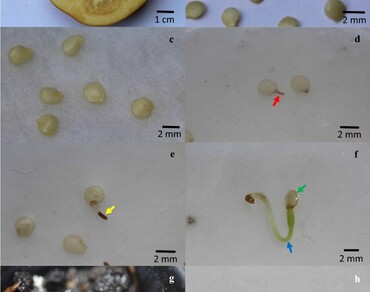Cocona (Solanum sessiliflorum Dunal) seed and seedling development based on the landmark phenological scale
Research Articles | Published: 14 March, 2022
First Page: 600
Last Page: 606
Views: 3628
Keywords: Solanaceae, Amazon, Seedling, Germination, Growth
Abstract
Cocona is a relevant crop from the Orinoco and Amazon regions. The current work aims to describe seed germination and seedling growth based on the landmark scale. Seeds were manually extracted from fruits, sown in plastic gemination beds and subsequently transplanted to pots. A total of 400 seeds were sown using a commercial potting substrate. Seeds were germinated and grown under greenhouse conditions at 13 °C in Bogotá, Colombia. Seeds and seedlings were photographed at every 10 days. Fresh seeds were sown directly from the fruit. Seed germination started with radicle emergence. Few root hairs were observed on the radicle as it elongated. Seed germination was epigeal. The seedling hypocotyl was unbent and emerged from the soil. A new bud emerged between opposing cotyledons. Cotyledons turned yellow before abscission. Leaf emergence was a continuous process. More than 17 leaves developed on the juvenile plant. The low (13 °C) temperature did not affect germination but significantly reduced juvenile plant growth.

References
Acosta-Quezada PGP, Riofrío-Cuenca T, Rojas J et al (2016) Phenological growth stages of tree tomato (Solanum betaceum Cav.), an emerging fruit crop, according to the basic and extended BBCH scales. Sci Hortic 199:216–223. https://doi.org/10.1016/j.scienta.2015.12.045
Benevide Sereno A, Bampi M, dos Santos IE et al (2018) Mineral profile, carotenoids and composition of cocona (Solanum sessiliflorum Dunal), a wild Brazilian fruit. J Food Compos Anal 72:32–38. https://doi.org/10.1016/J.JFCA.2018.06.001
Duarte O (2011) Cocona (Solanum sessiliflorum Dunal). In: Yahia E (ed) Postharvest biology and technology of tropical and subtropical fruits. Woodhead Publishing, Wallingford, pp 1–7
Duarte O, Paull R (2015) Exotic fruits and nuts of the New World. CABI, Wallingford
Heiser CB (1993) The naranjilla (Solanum quitoense), the cocona (Solanum sessiliflorum) and their hybrid. In: Gustafson P, Appels R, Raven P (eds) Gene conservation and exploitation. Springer, Boston, pp 29–34
Jiménez P (2018) Cocona—Solanum sessiliflorum. In: Rodrigues S, de Oliveira Silva E, Sousa de Brito E (eds) Exotic fruits reference guide. Academic Press, San Diego, pp 153–158
Lim T (2013) Edible medicinal and non-medicinal plants: Volume 6, fruits. Springer, New York
Meier U (2001) Growth stages of mono-and dicotyledonous plants: BBCH Monograph. New York
Moreno C, Quiñones JR, Jiménez P (2016) Phenological growth stages of Solanum sessiliflorum according to BBCH scale. Ann Appl Biol 168:151–157. https://doi.org/10.1111/aab.12251
Odonne G, Valadeau C, Alban-Castillo J et al (2013) Medical ethnobotany of the Chayahuita of the Paranapura basin (Peruvian Amazon). J Ethnopharmacol 146:127–153. https://doi.org/10.1016/j.jep.2012.12.014
Pahlen A (1977) Cubiu [Solanum topiro (Humb & Bonpl.)], uma fruteira da Amazônia. Acta Amaz 7:301–307
Pereira MD, Dos Santos CEM, Filho SM (2011) Germinação de sementes de cubiu (Solanum sessiliflorum Dunal). Rev Bras Ciencias Agrar 6:79–84. https://doi.org/10.5039/agraria.v6i1a962
Prance GT, Campbell DG, Nelson BW (1977) The ethnobotany of the Paumarí Indians. Econ Bot 31:129–139. https://doi.org/10.1007/BF02866582
Ramírez F (2020) Cocona (Solanum sessiliflorum Dunal) reproductive physiology: a review. Genet Resour Crop Evol 67:293–311. https://doi.org/10.1007/s10722-019-00870-x
Ramírez F (2021a) Notes about lulo (Solanum quitoense Lam.): an important South American underutilized plant. Genet Resour Crop Evol 68:93–100. https://doi.org/10.1007/s10722-020-01059-3
Ramírez F (2021b) Tree tomato (Solanum betaceum Cav.) grafted with a wild Solanum species. Genet Resour Crop Evol 68:2265–2271. https://doi.org/10.1007/s10722-021-01194-5
Ramírez F, Davenport T (2016) The phenology of the capuli cherry [Prunus serotina subsp. capuli (Cav.) McVaugh] characterized by the BBCH scale, landmark stages and implications for urban forestry in Bogotá. Colombia Urban for Urban Green 19:202–211. https://doi.org/10.1016/J.UFUG.2016.06.028
Ramírez F, Davenport T (2020) The development of lulo plants (Solanum quitoense Lam. var. septentrionale) characterized by BBCH and landmark phenological scales. Int J Fruit Sci 20:562–585. https://doi.org/10.1080/15538362.2019.1613470
Ramírez F, Kallarackal J (2019) Tree tomato (Solanum betaceum Cav.) reproductive physiology: a review. Sci Hortic 248:206–215. https://doi.org/10.1016/j.scienta.2019.01.019
Ramírez F, Fischer G, Davenport T et al (2013) Cape gooseberry (Physalis peruviana L.) phenology according to the BBCH phenological scale. Sci Hortic 162:39–42. https://doi.org/10.1016/j.scienta.2013.07.033
Ramírez F, Davenport T, Fischer G et al (2014) Mango trees have no distinct phenology: the case of mangoes in the tropics. Sci Hortic 168:258–266. https://doi.org/10.1016/J.SCIENTA.2014.01.040
Ramírez F, Davenport T (2021) Uchuva (Physalis peruviana L.) reproductive biology. Springer, Cham
Salick J (1992) Crop domestication and the evolutionary ecology of cocona (Solanum sessiliflorum Dunal). In: Hecht M, Wallace B, Ross J (eds) Evolutionary biology. Springer, New York, pp 247–285
da Silva Filho D (1998) Cocona (Solanum sessiliflorum Dunal): cultivo y utilización. Tratado de Cooperación Amazónica, Caracas
Smith N, Vázquez R, Wust W (2007) Amazon River fruits flavors and conservation. Missouri Botanical Garden Press, Peru
Vickers W, Plowman T (1984) Useful plants of the Siona and Secoya Indians of Eastern Ecuador. Fieldiana Bota 15:1–63
Volpato G, Marcucci R, Tornadore N, Paoletti MG (2006) Domestication process of two Solanum section Lasiocarpa species among Amerindians in the Upper Orinoco, Venezuela, with special focus on Piaroa Indians. Econ Bot 54:184–194. https://doi.org/10.1663/0013-0001(2004)058[0184:dpotss]2.0.co;2
Author Information
Bogotá, Colombia